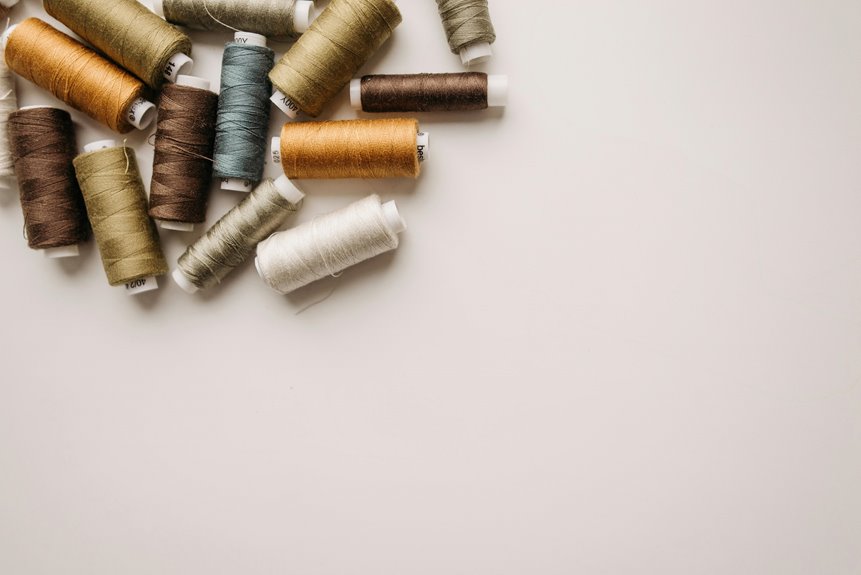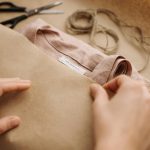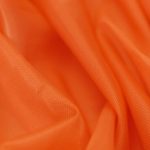Nonwoven fabric is made by bonding fibers like synthetic polyester, polypropylene, or nylon, and natural ones such as cotton or hemp. These fibers combine through mechanical, thermal, or chemical processes to create lightweight, durable, and breathable textiles. You’ll find them in masks, wipes, and hygiene products because they resist tears and moisture well. Some fabrics blend fibers to improve strength and comfort, while specialty fibers serve industrial needs. Keep exploring to discover how different fibers shape these versatile materials.
Table of Contents
Key Takeaways
- Nonwoven fabrics are made by bonding synthetic or natural fibers through mechanical, chemical, or thermal processes.
- Common synthetic fibers include polyester, polypropylene, and nylon, chosen for durability and moisture resistance.
- Natural fibers like cotton, wool, jute, flax, and hemp offer breathability, biodegradability, and comfort.
- Blended fibers, such as polyester-cotton blends, enhance strength, softness, and specific performance traits.
- Fiber bonding methods, including needle punching and thermal bonding, determine suitable fiber types and fabric properties.
Definition and Characteristics of Nonwoven Fabrics
Although you mightn’t always notice them, nonwoven fabrics play an essential role in many everyday products.
These fabrics differ from traditional woven or knitted textiles because they’re made by bonding fibers together through mechanical, chemical, or thermal processes instead of weaving or knitting.
When you handle nonwoven fabrics, you’ll find they’re lightweight, flexible, and often disposable, yet strong enough for practical use. They resist tears and punctures well, which makes them ideal for medical masks, filters, and hygiene products.
You’ll also appreciate their breathability and softness in items like wipes and protective garments. Understanding these characteristics helps you see why nonwoven fabrics offer unique advantages in diverse applications, blending functionality with cost-effective production methods.
Common Synthetic Fibers Used in Nonwoven Fabrics
Synthetic fibers form the backbone of many nonwoven fabrics you encounter daily. These fibers offer durability, flexibility, and resistance to moisture and chemicals, making them ideal for various applications. You’ll often find polyester, polypropylene, and nylon at the core of nonwoven fabric production.
Here’s a quick comparison:
| Fiber | Properties | Common Uses |
|---|---|---|
| Polyester | Strong, resistant to shrinking | Medical gowns, filters |
| Polypropylene | Lightweight, chemical resistant | Diapers, wipes |
| Nylon | High elasticity, abrasion resistant | Geotextiles, bags |
Knowing these fibers helps you understand why nonwovens perform so well in hygiene, industrial, and medical sectors, combining strength and comfort effectively.
Natural Fibers in Nonwoven Fabric Production
When you choose natural fibers for nonwoven fabrics, you tap into materials that offer breathability, biodegradability, and a softer touch.
These fibers come from plants or animals, making them eco-friendly options. You’ll find natural fibers like cotton, wool, jute, flax (linen), and hemp commonly used in nonwoven production.
Their unique properties help create fabrics ideal for hygiene products, medical supplies, and eco-conscious packaging.
Here’s what makes natural fibers stand out:
- Excellent moisture absorption
- Comfortable against skin
- Renewable and sustainable
- Biodegradable, reducing waste
- Good thermal insulation
Blended Fiber Compositions for Enhanced Performance
You’ll find that blending fibers like polyester with cotton or polypropylene can boost the strength and durability of nonwoven fabrics.
By combining fibers, you get the best qualities of each, improving breathability, softness, and resistance to wear.
Understanding these blends helps you choose materials that meet specific performance needs.
Common Fiber Blends
Blending two or more fibers allows manufacturers to combine the best qualities of each, creating nonwoven fabrics with enhanced strength, softness, or durability.
You’ll often find these common fiber blends in nonwoven fabrics:
- Polyester and Viscose: Balances durability with softness.
- Polypropylene and Polyester: Offers excellent strength and moisture resistance.
- Cotton and Polyester: Provides comfort with added durability.
- Nylon and Polyester: Enhances abrasion resistance and flexibility.
- Rayon and Polyester: Delivers a smooth feel while maintaining toughness.
Benefits of Blending
Combining different fibers in nonwoven fabrics releases a range of performance benefits that single fibers alone can’t achieve. When you blend fibers, you enhance durability, comfort, and functionality tailored to your needs. You get the strength of synthetic fibers with the softness of natural ones, plus improved absorbency or resistance.
| Benefit | Fiber Blend Example | Effect on Fabric |
|---|---|---|
| Strength | Polyester + Cotton | Increased tear resistance |
| Comfort | Rayon + Polypropylene | Softer feel with moisture wicking |
| Functionality | Nylon + Viscose | Enhanced breathability and durability |
Performance Improvement Factors
Although selecting the right fibers can be challenging, understanding how different blends enhance performance helps you make informed choices.
Blended fiber compositions combine the strengths of individual materials, resulting in nonwoven fabrics that meet specific needs more effectively. By mixing fibers, you can improve durability, flexibility, and functionality.
Consider these performance improvement factors when choosing blends:
- Enhanced tensile strength for better wear resistance
- Increased softness for comfort in wearable products
- Improved moisture wicking or water repellency
- Greater thermal insulation or breathability
- Optimized cost-efficiency without sacrificing quality
Fiber Bonding Techniques and Their Impact on Material Choice
When you select nonwoven fabrics, understanding fiber bonding techniques is essential because they directly influence the material’s strength, flexibility, and application.
You’ll encounter mechanical bonding methods like needle punching and hydroentangling, which physically entangle fibers, enhancing durability without adding chemicals.
Thermal bonding uses heat to fuse thermoplastic fibers, creating stronger, stiffer fabrics ideal for filtration or medical uses.
Chemical bonding involves adhesives to bind fibers, offering smooth surfaces and flexibility, often found in wipes or hygiene products.
Each bonding method demands specific fiber types; for instance, thermal bonding requires thermoplastic fibers like polypropylene or polyester.
Knowing these techniques helps you choose the right fiber and bonding combination, ensuring your nonwoven fabric meets performance requirements and suits your intended purpose efficiently.
Role of Polyester in Nonwoven Fabrics
Polyester plays a vital role in nonwoven fabrics thanks to its strength, durability, and versatility. When you choose polyester-based nonwovens, you benefit from materials that hold up well under stress and resist wear and tear.
Polyester fibers blend easily with other materials, enhancing fabric performance for many applications. Here’s why polyester stands out:
- High tensile strength for long-lasting durability
- Excellent resistance to moisture and chemicals
- Maintains shape and structure under various conditions
- Good thermal stability, allowing for heat bonding
- Cost-effective and widely available
Use of Polypropylene Fibers in Medical and Hygiene Products
You’ll find polypropylene fibers are key in medical masks and various hygiene products because they offer excellent filtration and breathability.
Their lightweight, moisture-resistant nature keeps you comfortable while providing reliable protection.
Let’s explore how these fiber benefits make polypropylene a top choice in healthcare and hygiene applications.
Polypropylene in Medical Masks
Although you mightn’t realize it, polypropylene fibers play an essential role in the effectiveness of medical masks.
These fibers create a lightweight, breathable barrier that filters out harmful particles while allowing you to breathe comfortably. When you wear a mask made from polypropylene, you benefit from its unique properties:
- Excellent filtration efficiency against viruses and bacteria
- Hydrophobic nature repels moisture, keeping the mask dry
- Durable and tear-resistant for reliable protection
- Electrostatic charge enhances particle capture without compromising airflow
- Cost-effective production enables widespread use in healthcare settings
Thanks to polypropylene, medical masks offer a practical balance of safety and comfort that helps protect both you and others during health crises.
Hygiene Products Fiber Benefits
When you choose hygiene products made with polypropylene fibers, you benefit from their exceptional strength and moisture resistance.
These fibers create a barrier that keeps you dry and comfortable, making them ideal for diapers, sanitary napkins, and wipes. Polypropylene’s lightweight and breathable nature also allows air circulation, reducing skin irritation and enhancing comfort during use.
Plus, its chemical resistance means hygiene products stay effective even when exposed to bodily fluids. Since polypropylene fibers don’t absorb moisture, they help maintain dryness, which is essential for preventing infections and skin issues.
You’ll also appreciate that these fibers are cost-effective and easy to produce, so manufacturers can provide reliable hygiene products without compromising quality or affordability.
Incorporation of Cellulose Fibers for Sustainability
Because sustainability has become a priority in textile production, incorporating cellulose fibers into nonwoven fabrics offers a promising solution.
Sustainability drives innovation, making cellulose fibers a key choice for eco-friendly nonwoven textiles.
You’ll find that cellulose fibers, derived from plants like wood pulp, cotton, and bamboo, bring eco-friendly benefits without sacrificing performance.
When you use these fibers, you’re adding:
- Biodegradability, reducing landfill waste
- Renewable sourcing, lowering environmental impact
- Breathability, enhancing comfort in end products
- Compatibility with various bonding methods
- Improved moisture absorption for hygiene products
Specialty Fibers for Technical and Industrial Applications
You’ll find specialty fibers like aramid and carbon fiber excel in technical and industrial settings due to their strength, heat resistance, and durability.
These high-performance fibers offer specific benefits that enhance product functionality and lifespan.
Understanding their unique properties helps you choose the right material for demanding applications.
High-Performance Fiber Types
Although high-performance fibers often cost more than standard options, they deliver exceptional strength, durability, and resistance to heat and chemicals that you need for demanding technical and industrial uses.
These fibers stand out by maintaining integrity under extreme conditions, making them ideal for specialized nonwoven fabrics.
When choosing fibers for your project, consider:
- Aramid fibers: Known for fire resistance and high strength.
- Carbon fibers: Offer excellent stiffness and lightweight properties.
- PBI (Polybenzimidazole): Exceptional thermal stability and chemical resistance.
- Glass fibers: Resist heat and provide structural reinforcement.
- Polyimide fibers: Maintain performance at ultra-high temperatures.
Industrial Application Benefits
When you select specialty fibers for industrial applications, you reveal benefits like enhanced durability, heat resistance, and chemical stability that standard materials can’t match. These fibers improve product lifespan, safety, and performance, reducing downtime and maintenance costs. You’ll find them in filtration, automotive parts, construction, and protective gear where reliability is critical.
| Benefit | Application Example |
|---|---|
| Enhanced Durability | Automotive insulation |
| Heat Resistance | Firefighter protective wear |
| Chemical Stability | Industrial filtration media |
Fiber Properties and Functions
Specialty fibers bring unique properties that directly influence their performance in technical and industrial settings.
When you choose nonwoven fabrics, understanding these fiber characteristics helps you select the best material for your needs. These fibers offer enhanced strength, durability, and functionality compared to standard options.
Here’s what specialty fibers can provide:
- High tensile strength for heavy-duty applications
- Resistance to chemicals and extreme temperatures
- Excellent filtration efficiency for clean environments
- Lightweight yet robust for easy handling
- Enhanced moisture management and breathability
Influence of Fiber Properties on Nonwoven Fabric Functionality
Since fiber properties directly impact a nonwoven fabric’s performance, understanding their influence is essential for selecting the right materials.
When you choose fibers with different lengths, strengths, or flexibility, you directly affect the durability, softness, and stretch of the final product. For example, longer fibers tend to create stronger fabrics, while finer fibers offer a softer feel.
The fiber’s moisture absorption also influences breathability and comfort, vital for medical or hygiene products. Additionally, the fiber’s chemical composition affects resistance to heat, chemicals, or UV exposure, shaping where and how you can use the fabric.
Frequently Asked Questions
How Are Nonwoven Fabrics Recycled or Disposed of After Use?
You can recycle some nonwoven fabrics by sorting and sending them to specialized facilities, but many end up in landfills or incinerators. Always check local guidelines, and consider reusable options to reduce waste after use.
What Are the Environmental Impacts of Producing Nonwoven Fabrics?
You’ll find producing nonwoven fabrics consumes energy and water, often releasing pollutants. Synthetic fibers can contribute to microplastic pollution. However, choosing eco-friendly materials and recycling can help reduce these environmental impacts considerably.
How Do Nonwoven Fabrics Compare in Cost to Woven Fabrics?
You’ll find nonwoven fabrics usually cost less than woven ones because they require less labor and time to produce. Their simpler manufacturing process keeps prices down, making them a budget-friendly choice for many applications.
What Are the Main Industries Using Nonwoven Fabrics Today?
You’ll find nonwoven fabrics mainly in healthcare, hygiene products, automotive, construction, and agriculture. They’re popular because they’re lightweight, cost-effective, and versatile, making them perfect for filters, masks, wipes, insulation, and packaging materials.
Can Nonwoven Fabrics Be Dyed or Printed on Effectively?
Just like a medieval scribe coloring illuminated manuscripts, you can dye or print on nonwoven fabrics effectively. Their porous structure absorbs colors well, so you’ll get vibrant, lasting designs, perfect for your creative projects.
- The Science of Nonwoven Fabric: How Fibers Become Fabric - July 11, 2025
- Nonwoven Fabric for Masks: What Makes a Good Filter? - July 11, 2025
- A Practical Guide to Using Nonwoven Geotextiles - July 11, 2025







